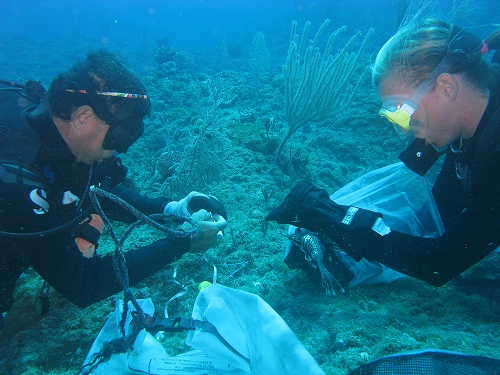October was a packed and exciting month for CEI’s Lionfish Research and Education Program (LREP). A new study tagging lionfish in a novel way is currently happening at CEI. This monitoring technique can help us track when, where, and how the lionfish are spawning. The hopes are that in the future we will be able to more effectively reduce population sizes.
Dr. Lad Akins, director of the Reef Environmental Education Foundation (REEF), spent a week at CEI to help make this project happen. Under his direction, accompanied by new LREP manager Dr. Jocelyn Curtis-Quick and interns, several acoustic receivers were placed at the edge of the Exuma Sound. Divers previously scouted this area to identify hotspots, or areas where several lionfish were found together, to place these receivers. After the receivers were set up, lionfish were captured to place tags inside their guts. This required underwater surgery on the lionfish, a procedure that had never been done before. Previously, when fish had been tagged, they had to be brought to the surface.This created pressure change health risks to the fish. There were also risks associated with placing fish under anesthesia. Underwater surgery solved all these problems. After performing the surgery with dummy tags and monitoring the fish’s recovery in tanks, the lionfish had a full recovery, returning to their normal behavior within a matter of minutes.
The receiver can pick up a lionfish tag within 1,000 meters and has a 50 meter depth range. When it receives a signal it records data on the lionfish’s activity every 45 seconds. This data is important because no one has seen an actual lionfish spawning event. From similar species, it is known that they spawn in pairs and they can release 30,000 eggs at a time. What we don’t know however, is where they are spawning. Is it at the surface? Or are they going down to greater depths? Is it done at night? Early morning? These questions and more can be answered when these receivers are collected in December 2012 to analyze the data.
